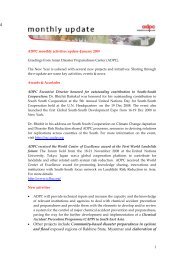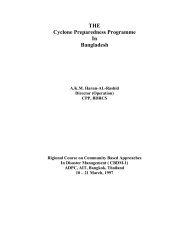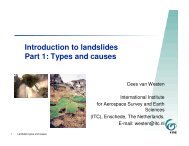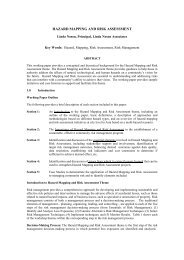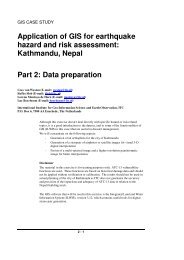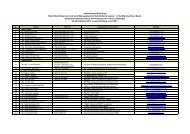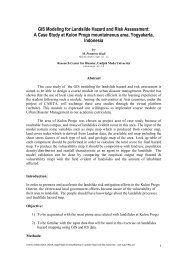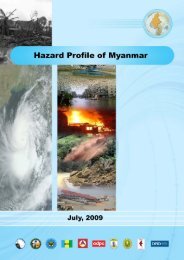community-based disaster risk management and the media media kit
community-based disaster risk management and the media media kit
community-based disaster risk management and the media media kit
You also want an ePaper? Increase the reach of your titles
YUMPU automatically turns print PDFs into web optimized ePapers that Google loves.
104<br />
MEDIA KIT<br />
• Offshore reefs <strong>and</strong> shallow areas may help break<br />
<strong>the</strong> force of tsunami waves, but large <strong>and</strong> dangerous<br />
waves can still be a threat to coastal residents in <strong>the</strong>se<br />
areas. Staying away from all low-lying coastal areas is<br />
<strong>the</strong> safest advice when <strong>the</strong>re is a tsunami warning.<br />
What to Do During a Tsunami<br />
• Listen to a radio or television for emergency information <strong>and</strong> be<br />
ready to evacuate if asked to do so.<br />
• Evacuate to high ground at once, with emergency supplies, if you<br />
hear an offi cial tsunami warning or detect signs of a tsunami.<br />
• Stay away from <strong>the</strong> beach. Don’t go down <strong>the</strong> beach to watch<br />
tsunami. If you can see <strong>the</strong> wave, you are too close to escape it.<br />
• Wait until you are sure it is safe to come down.<br />
• Be always calm <strong>and</strong> don’t panic.<br />
If You are on a Ship or Boat<br />
Since tsunami wave activity is imperceptible in <strong>the</strong> open ocean, do not<br />
return to port if you are at sea <strong>and</strong> a tsunami warning has been issued<br />
for your area. Tsunamis can cause rapid changes in water level <strong>and</strong><br />
unpredictable dangerous currents in harbors <strong>and</strong> ports.<br />
If <strong>the</strong>re is time to move your boat or ship from port to a<br />
location where <strong>the</strong> water is more than 400 m deep (<strong>and</strong><br />
after you know a tsunami warning has been issued), you<br />
should weigh <strong>the</strong> following considerations:<br />
• Most large harbors <strong>and</strong> ports are under <strong>the</strong> control<br />
of a harbor authority <strong>and</strong>/or a vessel traffi c system.<br />
These authorities direct operations during periods of<br />
increased readiness, including <strong>the</strong> forced movement of<br />
vessels if deemed necessary. Keep in contact with <strong>the</strong><br />
authorities, should a forced movement of vessels be<br />
directed.



